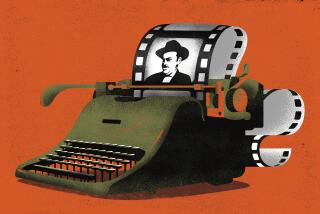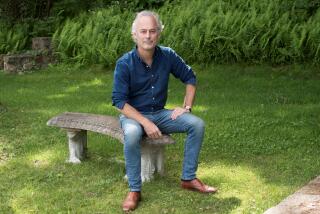Welles: Magic and Storytelling : BIOGRAPHY : ROSEBUD: The Story of Orson Welles,<i> By David Thomson (Alfred A. Knopf: $30; 463 pp.)</i>
David Thomson makes a point of telling us he’s nobody’s fool in “Rosebud,” least of all Orson Welles’. Despite “a life passed in awe” of the Great Man, his paradoxical demolition of his former idol is proof that a disillusioned idolater can make a sympathetic, if self-absorbed, biographer.
“Rosebud” bursts with compassion for the ambitious, self-destructive Welles, “who could not make a movie, or speak for more than a few minutes, without polishing his own legend.” The tenderness can hardly be missed. Thomson tells us, albeit with off-putting pretension: “My anguish and reverence are intertwined and immense.”
This biography is mischievous as well as self-important. More than sympathy, a skeptical cleverness pervades “Rosebud’s” pages. It is the author’s main signature. He’s a doubting Thomson: sardonic, savvy, aphoristic, blunt when he feels like it, always articulate.
Given his larger-than-life subject, he inevitably does some polishing of his own. He writes of “Moby Dick--Rehearsed,” a play Welles adapted from Melville and produced in the ‘50s: “I know that ‘Moby Dick’ was genius without ever having seen it.”
Indeed, Welles is termed a genius so often, you’d think he was more profound than Beethoven, smarter than Einstein. Young Orson was not just a prodigy “in matters of mind, learning and assertion”--he grew up into an Ahab-like “genius who had set himself in rivalry with God.”
Tales of the phenom are common. Peter Noble reported in “The Fabulous Orson Welles” (1956) that at 18 months the miraculous babe told Dr. Maurice Bernstein, “The desire to take medicine is one of the greatest features which distinguishes men from animals.” That’s what the good doctor (later to become “Dada” to Orson) said he said.
Frank Brady reported in “Citizen Welles” (1989) that, at age 8, Orson wrote a thesis called “The Universal History of Drama” and, at 10, was critiquing Nietzsche.
As a schoolboy he wrote, directed or starred in 30 plays at Todd School in Woodstock, Ill., and otherwise dominated his peers, hardly a friend among them. He then set out to astonish the world.
By subtitling “Rosebud” the story and not the life, Thomson is making a categoric distinction between this biography and its many predecessors. There are easily a baker’s dozen, most recently Simon Callow’s “The Road to Xanadu,” the first volume of what is likely to be the definitive life of Welles.
Thomson writes, “The walls that separate biography, autobiography and romance are not as distinct as the areas in a bookstore. No matter the amount of research that has been gathered and digested for the work of nonfiction, still the story has to be told. Readers want story: They want things to hang together. Readers love rosebuds.”
No ordinary Hollywood scribe, Thomson has always shown remarkable versatility: expert film scholar, trenchant critic, encyclopedic historian and novelist. But the facts, if not the piquant trappings of “Rosebud,” are familiar. This puts a bit of a crimp in the freshness of the material.
Born George Orson Welles in Kenosha, Wis., in 1915, Orson was orphaned at 16, went off to Ireland at 17 and bluffed his way onto the stage at Dublin’s Gate Theatre for his professional debut. He showed heady talent, manly voice and--almost as important--the sort of youthful beauty that appealed to the theatrical mentors who hired him.
Welles later described himself during this period as “the Lily Langtry of the homosexual set”--in other words, adored but unattainable. This leads Thomson into a meditation on the possibility that Welles was a repressed homosexual. (Incidentally, Welles was married four times, once to Rita Hayworth; he almost married Dolores Del Rio, another beauty; and he was notorious for his affairs with many actresses.)
The up-and-coming actor, writer and soon-to-be director returned to New York from Dublin, notices preceding him, and was offered the right introductions, to Thornton Wilder and Alexander Woollcott in particular. With the instincts of a born coquette and the skills of a witty self-promoter--to say nothing of his silver-tongued theatrical gifts--Welles was a slam dunk. In short order, he was barnstorming the country with Katherine Cornell and Basil Rathbone, doing Shakespeare and Shaw.
Thomson recounts all this and the rest of the landmarks: meeting John Houseman, who became Welles’ closest collaborator and eventually--Welles chose to believe--his nemesis; working as a radio actor during the Depression; directing for the Negro Theatre Project, where he made a big splash in Harlem with an all-black, voodoo-style “MacBeth”; his and Houseman’s creation of the vanguard Mercury Theatre; the famous “War of the Worlds” radio hoax that had thousands believing that Martians had landed; the nonpareil invitation to Hollywood; the making of “Citizen Kane”; and the long, sad, self-inflicted decline.
But Thomson is no slave to facts. “Rosebud” is nothing if not a distillation of every speculative thought he has ever had about the myth and the man, and all his movies. (When Welles asked his authorized biographer Barbara Leaming to inject herself into her “Orson Welles”--brought out in 1985, the year he died--he could not have dreamed of the very personal transfusion he gets here.)
Thomson takes Welles’ masterwork--”Citizen Kane,” made at 26, and the only movie he completed to his satisfaction--as a biographical metaphor for Welles’ lack of faith in himself and, ultimately, in his art. He insists that “Kane” presaged the dwindling of Welles’ career, not just the promise--which may seem perverse, but the argument is persuasive.
Forget Charles Foster Kane, the ostensible William Randolph Hearst. The picture “is a cold, candid self-assessment by a solipsist,” Thomson writes. “Perhaps [Herman] Mankiewicz conceived the character and wrote the lines. But Welles delivered them as if they were his own death sentence. . . .”
Discussing the last of Welles’ 12 finished pictures--”F For Fake” (1973)--in which the maestro played a consummate fraud who blurs the line between fact and fiction--Thomson cherishes the idea that the record itself “is like our memories of sex and love--unforgettable and unreliable.” He savors the claim that someone as enthralled with the magician’s art as Welles naturally would turn himself into a masterpiece of subterfuge.
Thomson puts it neatly: “Magic and storytelling are the liar’s parole.” Welles had “an effortless way of reordering the past so that responsibility and real damage were glossed over.” Unfortunately, he was fatally greedy, in Thomson’s view. “Rosebud” takes as emblematic the fable about the scorpion and the frog, which Welles retold in “Mr. Arkadin” (1955).
The moral of the story--that one’s nature wins out over logic and even self-interest--appeals to Thomson’s love of paradox, and he keeps coming back to it. Though he does not believe any single meaning can explain anyone’s life, the fable’s meaning is rosebud enough. Welles obscured the record, conflating fact with fiction, because it was in his nature. Both his art and life were predicated on the same bleak narcissism with which he imbued Charles Foster Kane, his greatest role.
Welles “never mustered more than a passing interest in anyone except himself,” Thomson writes. The master “shaped everything, not least his failure and the legend of a rosebud that never quite bloomed.”
Nothing new or startling perhaps. Even so, “Rosebud” is a penetrating biography that takes risks; it’s also eloquent, whatever the flaws. Thompson has put his unmistakable stamp on Welles.
More to Read
Sign up for our Book Club newsletter
Get the latest news, events and more from the Los Angeles Times Book Club, and help us get L.A. reading and talking.
You may occasionally receive promotional content from the Los Angeles Times.







